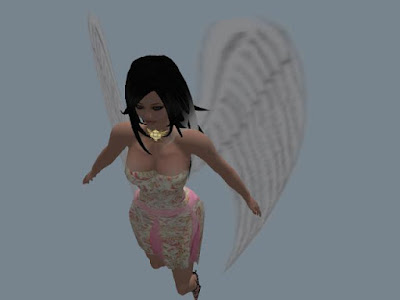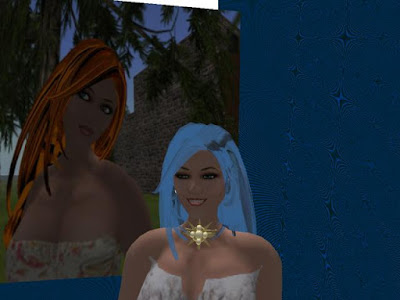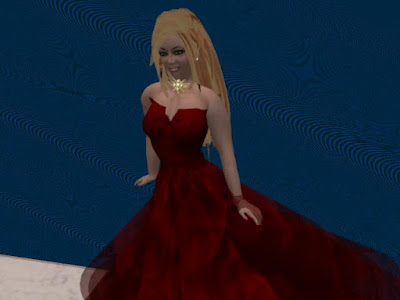The story of my first steps in Second Life
Hi dear friends:
This is the story about my first steps in Second Life (SL).
I created my account in SL two years ago, but I never could go inworld because of technical limitations. I had heard about SL from Webheads in Action, from Gavin Dudeney (Consultants-e), from Graham Stanley (British Council-Spain) and from my colleagues and friends Dafne González (USB) and Miguel Mendoza (UCV). They all talked to me about how wonderful this virtual world was. I really wanted to try it. I was curious about it, but my computer crashed every time I tried. Fortunately this year, in a new computer, I could sucessfully download the program and it run perfectly. I created a new avatar with a new name, because I had forgotten the one I had created two years before, and this exciting experience started. So, let me introduce you Evelyn Michalski, my avatar in SL.

My First Avatar
My first hours in SL were very exciting. I really enjoyed editing my avatar's appearance, changing her look, learning how to walk, chatting to others and learning how to use all those buttons and menu options. It was a complete new world for me; I was exploring and discovering as a little kid. I had heard about SL and seen some snapshots, but it is not the same being inworld and learn how to control yourself. For example, I didn't know how to see myself, just when editing my avatar's appearance; I didn't know how to use the camera controls; flying and softly landing, not crashing on the floor. Oops, it really hurt :-)). I usually found people around, but I was afraid of offering or accepting friendship because I didn't know who they were; and, I didn´t know how to use the maps or a TP, among other things.
By September 2008, I joined a group of trainees who would be part of the new Spanish teaching staff of Languagelab.com. Our mentors, Daf Smirnov and Anna Begonia introduced us to the SL fascinating world. They offered a four-week training in which we would learn and develop different abilities to use the SL tools and how to teach Spanish as a second language. It was fun and interesting at the same time. I was exploring new tools and discovering a world that demanded a great effort from me when developing a class. I had to take into account all what my avatar did, and at the same time, observing what the others were doing (the trainees simulated being students) and following a lesson plan.
It was not easy at the beginning. I was a total newbie, but in every session we developed new abilities and I felt more confident. Besides, some friends of mine were also trainees and we had fun together. By the way, they are also taking this Muvenation course: Nelba Quintana and Jennifer Verschoor, both from Argentina. We are all
Webheads like Dafne, Sus, Nergiz, Teresa, Moira, Serpil and Alicia.
Teaching in RL is totally different from teaching in SL. In SL you need to develop other abilities you almost never use in a classroom, for example: controlling the audio, listening and speaking by using the appropriate volume, walking in the right direction, using note cards, transfering landmarks, using the maps and camera controls, teletransporting or sending a TP, communicate with others by IM or local chat, creating objetcts or prims, adding or modifying scripts, flying, etc. In RL, you just give your class following a lesson plan, but in SL you have to develop your class and, simultanously, you have to be aware of/and control all the technical aspects. Here you will see some snapshots taken by Daf during our first and second weeks.
 Learning how to walk
Learning how to walk
 Learning how to fly
Learning how to fly
 Learning how to create objects, manipulate prims and scripts
Learning how to create objects, manipulate prims and scripts
My/our first task in the training was designing a mini-lesson. I would play the role of the teacher and the other participants would simulate to be students. At the end of the class, we would provide feedback to one another. My first class was about 'Dimensions and Genre'.

In our second week, our task was to design another class, but this time we should show our SL abilities developed until that moment. It was an experience even more challenging than the class before. My second mini-class was about 'Professions':
 During the week, trying to make some changes to the appearance of my avatar I had my first accident in SL. The feeling was terrible. Yes, I had never felt something like that. I don't know how but I suddenly became a bald man. I was athletic but short and my face's features were totally different. Oh no!!! Desperated trying to change her (or his) appearance, it become worse and worse. Well, I inmediately decided to go shopping and buy a new skin for my avatar. What a relief! At that time, I didn't know how to keep my avatar's skin. I'm so sorry because I really liked her. But well, I was born again. I changed some features to the new avatar and voilà. Here is Evelyn Michalski now.
During the week, trying to make some changes to the appearance of my avatar I had my first accident in SL. The feeling was terrible. Yes, I had never felt something like that. I don't know how but I suddenly became a bald man. I was athletic but short and my face's features were totally different. Oh no!!! Desperated trying to change her (or his) appearance, it become worse and worse. Well, I inmediately decided to go shopping and buy a new skin for my avatar. What a relief! At that time, I didn't know how to keep my avatar's skin. I'm so sorry because I really liked her. But well, I was born again. I changed some features to the new avatar and voilà. Here is Evelyn Michalski now.

Fortunately, I could solve that situation before my third and last mini class. The third class was a team teaching experience. What an interesting experience, indeed! It was more challenging and demanding this time, at this level we had to a) manage all SL tools, b) design a lesson plan with a partner, and c) perform the class within the Languagelab Sim. I worked with Magaly Rodríguez (Maga Randt in SL), a teacher who works at Universidad Simón Bolívar. We did a great job together, in spite of the stress of being under evaluation. It was my first team teaching experience in SL. I was too nervous, we had to exchange roles (teacher and assistant) during the class while performing and showing our SL tool management abilities. What a challenge! Our class was about 'Hotel Reservations'. It was a total success! :-)

Maga Randt is on the right with the shiny shoes
I would like to take advantage of this post to express my gratitude to Languagelab.com for such a great opportunity, for the excellent Spanish training program, and for assigning Daf as our mentor. She did an excellent, awesome and wonderful job.
Well, this is the story of my first steps in SL only with Languagelab. I have also visited other Sims, other islands and many interesting places. I promise to continue the story and bring a slideshow soon.
Regards,
Evelyn Michaslki





 This is me as Vivi
This is me as Vivi




 In NMC, I met my friend Tamara Ashton (Jennifer Verschoor in RL) and we explored the orientation island together. We checked, step by step, all what we were supposed to know according to the training received with Languagelab, until we got to a video station. We got distracted there. I saw San Francisco's trolley, which made me remind my visit to that city. That was our first distractor, then we walked around and passed over the Golden Gate bridge. We completely forgot the other stations and we never came back to complete the steps, but we have come several times to plan our micro-class. The fact of not finishing the circuit indicates that something wrong is happening. Perhaps, it is too long, or it has some distractors on the way to make the SL learner get some rest. I'm not clear about the purpose of this specific design. I really liked it, but it would be advisable to have someone around who provides some help or guidance. We have never found anybody there.
In NMC, I met my friend Tamara Ashton (Jennifer Verschoor in RL) and we explored the orientation island together. We checked, step by step, all what we were supposed to know according to the training received with Languagelab, until we got to a video station. We got distracted there. I saw San Francisco's trolley, which made me remind my visit to that city. That was our first distractor, then we walked around and passed over the Golden Gate bridge. We completely forgot the other stations and we never came back to complete the steps, but we have come several times to plan our micro-class. The fact of not finishing the circuit indicates that something wrong is happening. Perhaps, it is too long, or it has some distractors on the way to make the SL learner get some rest. I'm not clear about the purpose of this specific design. I really liked it, but it would be advisable to have someone around who provides some help or guidance. We have never found anybody there. 






 During the week, trying to make some changes to the appearance of my avatar I had my first accident in SL. The feeling was terrible. Yes, I had never felt something like that. I don't know how but I suddenly became a bald man. I was athletic but short and my face's features were totally different. Oh no!!! Desperated trying to change her (or his) appearance, it become worse and worse. Well, I inmediately decided to go shopping and buy a new skin for my avatar. What a relief! At that time, I didn't know how to keep my avatar's skin. I'm so sorry because I really liked her. But well, I was born again. I changed some features to the new avatar and voilà. Here is Evelyn Michalski now.
During the week, trying to make some changes to the appearance of my avatar I had my first accident in SL. The feeling was terrible. Yes, I had never felt something like that. I don't know how but I suddenly became a bald man. I was athletic but short and my face's features were totally different. Oh no!!! Desperated trying to change her (or his) appearance, it become worse and worse. Well, I inmediately decided to go shopping and buy a new skin for my avatar. What a relief! At that time, I didn't know how to keep my avatar's skin. I'm so sorry because I really liked her. But well, I was born again. I changed some features to the new avatar and voilà. Here is Evelyn Michalski now. 
